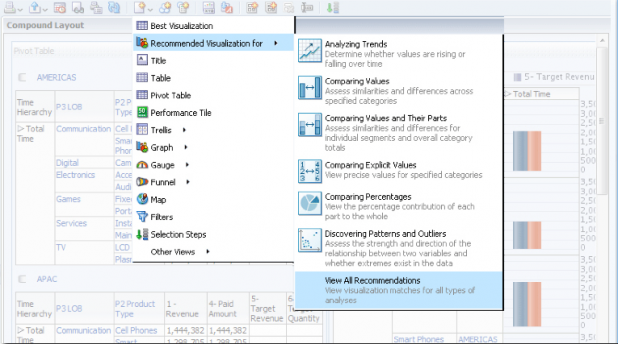 Oracle's latest product tweaks emphasize visualization.[/caption] Oracle has announced updates to its business-analytics software, including its information-discovery and data integration tools. But is the company’s Big Data strategy enough to dent its rivals’ extensive, loudly marketed efforts? First, the updates: Oracle’s Endeca Information Discovery 3.0 features a completely redesigned interface that seems to emphasize usability, with drag-and-drop visualizations; users can also add their own Excel files to their company datasets. The platform includes Oracle BI Server connectivity, which can pipeline in data from existing analytics applications. Oracle’s Business Intelligence Foundation Suite Release 11.1.1.7 features usability and mobility enhancements, including visualization and reporting features; Oracle is also pushing the Oracle Exalytics In-Memory Machine, which runs analytics on “optimized” hardware. The latter can be viewed as yet another Oracle attempt to sell customers an integrated hardware-software package, an increasingly difficult proposition at a time when companies are increasingly gravitating toward cloud software as the solution to their various business needs. But the cloud has evolved into something of a trouble spot for Oracle in recent years. For years, the company profited enormously from selling those integrated hardware-software stacks. Faced with increasing competition from cloud providers such as Salesforce, Oracle veered hard for the cloud in 2012, unveiling Oracle Cloud (loaded with enterprise-grade applications-as-services) and buying up a handful of Software-as-a-Service (SaaS) providers. In the short term, however, those efforts have yet to bear significant fruit: Oracle’s revenues for its fiscal 2013 Q3 were down 1 percent, to $9.0 billion, while new software licenses and cloud-software subscription revenues dipped 2 percent, to $2.3 billion. In the realm of data analytics, Oracle also faces substantial rivalries from a plethora of big IT vendors, including IBM and SAP. These companies are all working hard—through internal development and acquisition—to build out their offerings, and many of them are taking rather unique approaches to analytics (such as SAP’s full body-hug of in-memory technology) that could force Oracle to spread itself thin in order to compete against them all, should it choose to head down that road. In enterprise tech, you ignore Oracle’s efforts at your peril; but Oracle, like any company, faces dangers of its own. Image: Oracle
Oracle's latest product tweaks emphasize visualization.[/caption] Oracle has announced updates to its business-analytics software, including its information-discovery and data integration tools. But is the company’s Big Data strategy enough to dent its rivals’ extensive, loudly marketed efforts? First, the updates: Oracle’s Endeca Information Discovery 3.0 features a completely redesigned interface that seems to emphasize usability, with drag-and-drop visualizations; users can also add their own Excel files to their company datasets. The platform includes Oracle BI Server connectivity, which can pipeline in data from existing analytics applications. Oracle’s Business Intelligence Foundation Suite Release 11.1.1.7 features usability and mobility enhancements, including visualization and reporting features; Oracle is also pushing the Oracle Exalytics In-Memory Machine, which runs analytics on “optimized” hardware. The latter can be viewed as yet another Oracle attempt to sell customers an integrated hardware-software package, an increasingly difficult proposition at a time when companies are increasingly gravitating toward cloud software as the solution to their various business needs. But the cloud has evolved into something of a trouble spot for Oracle in recent years. For years, the company profited enormously from selling those integrated hardware-software stacks. Faced with increasing competition from cloud providers such as Salesforce, Oracle veered hard for the cloud in 2012, unveiling Oracle Cloud (loaded with enterprise-grade applications-as-services) and buying up a handful of Software-as-a-Service (SaaS) providers. In the short term, however, those efforts have yet to bear significant fruit: Oracle’s revenues for its fiscal 2013 Q3 were down 1 percent, to $9.0 billion, while new software licenses and cloud-software subscription revenues dipped 2 percent, to $2.3 billion. In the realm of data analytics, Oracle also faces substantial rivalries from a plethora of big IT vendors, including IBM and SAP. These companies are all working hard—through internal development and acquisition—to build out their offerings, and many of them are taking rather unique approaches to analytics (such as SAP’s full body-hug of in-memory technology) that could force Oracle to spread itself thin in order to compete against them all, should it choose to head down that road. In enterprise tech, you ignore Oracle’s efforts at your peril; but Oracle, like any company, faces dangers of its own. Image: Oracle Oracle Updates Its BI Tools, But Does It Have the Right Data Strategy?
[caption id="attachment_9018" align="aligncenter" width="618"]  Oracle's latest product tweaks emphasize visualization.[/caption] Oracle has announced updates to its business-analytics software, including its information-discovery and data integration tools. But is the company’s Big Data strategy enough to dent its rivals’ extensive, loudly marketed efforts? First, the updates: Oracle’s Endeca Information Discovery 3.0 features a completely redesigned interface that seems to emphasize usability, with drag-and-drop visualizations; users can also add their own Excel files to their company datasets. The platform includes Oracle BI Server connectivity, which can pipeline in data from existing analytics applications. Oracle’s Business Intelligence Foundation Suite Release 11.1.1.7 features usability and mobility enhancements, including visualization and reporting features; Oracle is also pushing the Oracle Exalytics In-Memory Machine, which runs analytics on “optimized” hardware. The latter can be viewed as yet another Oracle attempt to sell customers an integrated hardware-software package, an increasingly difficult proposition at a time when companies are increasingly gravitating toward cloud software as the solution to their various business needs. But the cloud has evolved into something of a trouble spot for Oracle in recent years. For years, the company profited enormously from selling those integrated hardware-software stacks. Faced with increasing competition from cloud providers such as Salesforce, Oracle veered hard for the cloud in 2012, unveiling Oracle Cloud (loaded with enterprise-grade applications-as-services) and buying up a handful of Software-as-a-Service (SaaS) providers. In the short term, however, those efforts have yet to bear significant fruit: Oracle’s revenues for its fiscal 2013 Q3 were down 1 percent, to $9.0 billion, while new software licenses and cloud-software subscription revenues dipped 2 percent, to $2.3 billion. In the realm of data analytics, Oracle also faces substantial rivalries from a plethora of big IT vendors, including IBM and SAP. These companies are all working hard—through internal development and acquisition—to build out their offerings, and many of them are taking rather unique approaches to analytics (such as SAP’s full body-hug of in-memory technology) that could force Oracle to spread itself thin in order to compete against them all, should it choose to head down that road. In enterprise tech, you ignore Oracle’s efforts at your peril; but Oracle, like any company, faces dangers of its own. Image: Oracle
Oracle's latest product tweaks emphasize visualization.[/caption] Oracle has announced updates to its business-analytics software, including its information-discovery and data integration tools. But is the company’s Big Data strategy enough to dent its rivals’ extensive, loudly marketed efforts? First, the updates: Oracle’s Endeca Information Discovery 3.0 features a completely redesigned interface that seems to emphasize usability, with drag-and-drop visualizations; users can also add their own Excel files to their company datasets. The platform includes Oracle BI Server connectivity, which can pipeline in data from existing analytics applications. Oracle’s Business Intelligence Foundation Suite Release 11.1.1.7 features usability and mobility enhancements, including visualization and reporting features; Oracle is also pushing the Oracle Exalytics In-Memory Machine, which runs analytics on “optimized” hardware. The latter can be viewed as yet another Oracle attempt to sell customers an integrated hardware-software package, an increasingly difficult proposition at a time when companies are increasingly gravitating toward cloud software as the solution to their various business needs. But the cloud has evolved into something of a trouble spot for Oracle in recent years. For years, the company profited enormously from selling those integrated hardware-software stacks. Faced with increasing competition from cloud providers such as Salesforce, Oracle veered hard for the cloud in 2012, unveiling Oracle Cloud (loaded with enterprise-grade applications-as-services) and buying up a handful of Software-as-a-Service (SaaS) providers. In the short term, however, those efforts have yet to bear significant fruit: Oracle’s revenues for its fiscal 2013 Q3 were down 1 percent, to $9.0 billion, while new software licenses and cloud-software subscription revenues dipped 2 percent, to $2.3 billion. In the realm of data analytics, Oracle also faces substantial rivalries from a plethora of big IT vendors, including IBM and SAP. These companies are all working hard—through internal development and acquisition—to build out their offerings, and many of them are taking rather unique approaches to analytics (such as SAP’s full body-hug of in-memory technology) that could force Oracle to spread itself thin in order to compete against them all, should it choose to head down that road. In enterprise tech, you ignore Oracle’s efforts at your peril; but Oracle, like any company, faces dangers of its own. Image: Oracle
 Oracle's latest product tweaks emphasize visualization.[/caption] Oracle has announced updates to its business-analytics software, including its information-discovery and data integration tools. But is the company’s Big Data strategy enough to dent its rivals’ extensive, loudly marketed efforts? First, the updates: Oracle’s Endeca Information Discovery 3.0 features a completely redesigned interface that seems to emphasize usability, with drag-and-drop visualizations; users can also add their own Excel files to their company datasets. The platform includes Oracle BI Server connectivity, which can pipeline in data from existing analytics applications. Oracle’s Business Intelligence Foundation Suite Release 11.1.1.7 features usability and mobility enhancements, including visualization and reporting features; Oracle is also pushing the Oracle Exalytics In-Memory Machine, which runs analytics on “optimized” hardware. The latter can be viewed as yet another Oracle attempt to sell customers an integrated hardware-software package, an increasingly difficult proposition at a time when companies are increasingly gravitating toward cloud software as the solution to their various business needs. But the cloud has evolved into something of a trouble spot for Oracle in recent years. For years, the company profited enormously from selling those integrated hardware-software stacks. Faced with increasing competition from cloud providers such as Salesforce, Oracle veered hard for the cloud in 2012, unveiling Oracle Cloud (loaded with enterprise-grade applications-as-services) and buying up a handful of Software-as-a-Service (SaaS) providers. In the short term, however, those efforts have yet to bear significant fruit: Oracle’s revenues for its fiscal 2013 Q3 were down 1 percent, to $9.0 billion, while new software licenses and cloud-software subscription revenues dipped 2 percent, to $2.3 billion. In the realm of data analytics, Oracle also faces substantial rivalries from a plethora of big IT vendors, including IBM and SAP. These companies are all working hard—through internal development and acquisition—to build out their offerings, and many of them are taking rather unique approaches to analytics (such as SAP’s full body-hug of in-memory technology) that could force Oracle to spread itself thin in order to compete against them all, should it choose to head down that road. In enterprise tech, you ignore Oracle’s efforts at your peril; but Oracle, like any company, faces dangers of its own. Image: Oracle
Oracle's latest product tweaks emphasize visualization.[/caption] Oracle has announced updates to its business-analytics software, including its information-discovery and data integration tools. But is the company’s Big Data strategy enough to dent its rivals’ extensive, loudly marketed efforts? First, the updates: Oracle’s Endeca Information Discovery 3.0 features a completely redesigned interface that seems to emphasize usability, with drag-and-drop visualizations; users can also add their own Excel files to their company datasets. The platform includes Oracle BI Server connectivity, which can pipeline in data from existing analytics applications. Oracle’s Business Intelligence Foundation Suite Release 11.1.1.7 features usability and mobility enhancements, including visualization and reporting features; Oracle is also pushing the Oracle Exalytics In-Memory Machine, which runs analytics on “optimized” hardware. The latter can be viewed as yet another Oracle attempt to sell customers an integrated hardware-software package, an increasingly difficult proposition at a time when companies are increasingly gravitating toward cloud software as the solution to their various business needs. But the cloud has evolved into something of a trouble spot for Oracle in recent years. For years, the company profited enormously from selling those integrated hardware-software stacks. Faced with increasing competition from cloud providers such as Salesforce, Oracle veered hard for the cloud in 2012, unveiling Oracle Cloud (loaded with enterprise-grade applications-as-services) and buying up a handful of Software-as-a-Service (SaaS) providers. In the short term, however, those efforts have yet to bear significant fruit: Oracle’s revenues for its fiscal 2013 Q3 were down 1 percent, to $9.0 billion, while new software licenses and cloud-software subscription revenues dipped 2 percent, to $2.3 billion. In the realm of data analytics, Oracle also faces substantial rivalries from a plethora of big IT vendors, including IBM and SAP. These companies are all working hard—through internal development and acquisition—to build out their offerings, and many of them are taking rather unique approaches to analytics (such as SAP’s full body-hug of in-memory technology) that could force Oracle to spread itself thin in order to compete against them all, should it choose to head down that road. In enterprise tech, you ignore Oracle’s efforts at your peril; but Oracle, like any company, faces dangers of its own. Image: Oracle 
